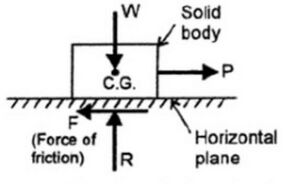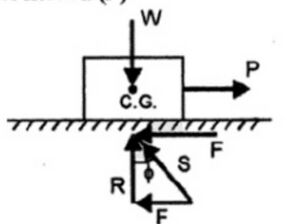Friction: Difference between revisions
No edit summary |
|||
| Line 59: | Line 59: | ||
*# Solid Friction - When the two surfaces have sliding motion relative to each other , then the friction between the two surfaces is known as Solid Friction. Ex: friction occurring when we push a wooden box on the floor | *# Solid Friction - When the two surfaces have sliding motion relative to each other , then the friction between the two surfaces is known as Solid Friction. Ex: friction occurring when we push a wooden box on the floor | ||
*# Rolling Friction - When one surface is rolling over another surface, then the friction between the two surfaces is known as Rolling Friction. Ex : friction between ball and roller bearing | *# Rolling Friction - When one surface is rolling over another surface, then the friction between the two surfaces is known as Rolling Friction. Ex : friction between ball and roller bearing | ||
* Greasy Friction - When the two surfaces in contact have a very thin layer of lubricant between them, the friction between those surfaces | * Greasy Friction - When the two surfaces in contact have a very thin layer of lubricant between them, the friction between those surfaces is known as Greasy Friction. The lubricant is absorbed on the surfaces and forms a very thin film between these surfaces. | ||
* Viscous Friction - | * Viscous Friction - When the two surfaces in contact have a thick layer of lubricant between them, the friction between those surfaces is known as Viscous Friction. Here the surfaces do not come in contact and hence do not rub against each other. Surfaces will have rubbing action with the thick layer of lubricant only. | ||
=== Laws of Dry Friction === | |||
# The force of friction acts in the opposite direction in which surface is having tendency to move. | |||
# The force of friction | |||
== External Links == | == External Links == | ||
Revision as of 23:07, 26 September 2022
When a solid body slides over a stationary solid body, a force is exerted at the surface of contact by the stationary body on the moving body. This force is called as the force of friction and is always acting in the direction opposite to the direction of motion. Friction is a property of the bodies by virtue of which a force is exerted by a stationary body on the moving body to resist the motion of the moving body. Friction acts parallel to the surface of contact and depends on the nature of surface of contact.
The different contact surfaces are i) dry ii) partially lubricated (greasy) iii) completely lubricated (film lubricated).
Force of friction should be reduced or increased. Reducing the force of friction is needed when the power transmitted is partially lost due to friction, the friction must be reduced by using lubricated surfaces.
Terminology
Consider a solid body placed on a horizontal plane surface.
W = Weight of body acting through centre of gravity downward,
R = Normal reaction of body acting through centre of gravity upward,
P = Force acting on the body through centre of gravity parallel to the horizontal surface
if the force P is small , the body will not move as the force of friction F acting on the body in the opposite direction of force P will be more than P. But if the force P is increased at some point when the solid body is on the point of motion.
Limiting force of friction
At that point force of friction F acting on the body is called limiting force of friction. Limiting force of friction is denoted by F.
By resolving the horizontal and vertical forces acting on the body we get R = W and F = P
Kinetic Friction
if the force P is increased further the body will start moving. The force of friction acting on the body, when the body is moving is called Kinetic Friction.
Coefficient of Friction (μ)
Hence F = μR ........................ (1)
Ange of Friction (Φ)
Angle of friction is the angle made by the resultant of the normal reaction (R) and the limiting force of Friction (F) with the normal reaction (R) which is denoted by Φ. Fig 2. shows a solid body resting on a rough horizontal plane.
Let S is the resultant of normal reaction (R) and limiting force of Friction (F)
Angle of friction (Φ) = angle between S & R
since F = μR from (1)
...........(2)
So the tangent of the angle of friction is equal to the coefficient of friction.
Types of Friction
Based on the nature of two surfaces in contact friction is classified as
- Static Friction - Two surfaces are in contact and at rest , the force experienced by one surface is called Static Friction.
- Dynamic Friction - One surface starts moving while the other is at rest , the force experience by the moving surface is called Dynamic Friction.
Based on the conditions of surfaces friction is classified as
- Dry Friction - The friction that exists between the two surfaces when no lubricant is used is called Dry Friction. It is further classified as
- Solid Friction - When the two surfaces have sliding motion relative to each other , then the friction between the two surfaces is known as Solid Friction. Ex: friction occurring when we push a wooden box on the floor
- Rolling Friction - When one surface is rolling over another surface, then the friction between the two surfaces is known as Rolling Friction. Ex : friction between ball and roller bearing
- Greasy Friction - When the two surfaces in contact have a very thin layer of lubricant between them, the friction between those surfaces is known as Greasy Friction. The lubricant is absorbed on the surfaces and forms a very thin film between these surfaces.
- Viscous Friction - When the two surfaces in contact have a thick layer of lubricant between them, the friction between those surfaces is known as Viscous Friction. Here the surfaces do not come in contact and hence do not rub against each other. Surfaces will have rubbing action with the thick layer of lubricant only.
Laws of Dry Friction
- The force of friction acts in the opposite direction in which surface is having tendency to move.
- The force of friction

